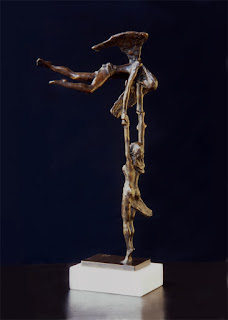Mutual Creation
Mutual Creation
by Leonardo Pereznieto
Bronze, 13” x 7 1/2" X 6 1/4”
This sculpture represents the concept that a loving couple is always, to some degree, modeling each other, as well as letting themselves being modeled. Through their relationship they help build each other, they assist their partner to become better, and they inspire one another. They are, perpetually, in a mutual creation.
____
Following is the introduction that writer Claudia Moscovici made for it:
In the Symposium, Plato compared the process of artistic inspiration to the process of falling in love. Love, like artistic creation, begins as a form of strong physical attraction, the act of being drawn to someone or something’s beauty. But once you fall in love you come to know and appreciate the deeper aspects of the person you love, or, in the case of art, of the object you see and touch.
Leonardo Pereznieto’s sculpture, Mutual Creation, like Plato’s Dialogue, represents love as an inspired, creative process. What is striking about this sculpture is the fact that, as its title suggests, Leonardo acknowledges the mutuality of the process of loving, as well as that of artistic inspiration and creation.
For Plato, in love there is an active lover (usually male) and a passive beloved (usually female or at least feminized), just like in art there is an inspired artist and an inspiring muse. Leonardo’s updated representation of Plato’s analogy between love and art, however, reveals a symmetry between man and woman, creator and muse, loved and beloved. The active and passive dichotomy is exposed as artificial.
Both the male and the female figures caress one another in a gesture that simultaneously reveals tenderness, attraction as well as the continual mutual inspiration without which love, like art, cannot exist.









